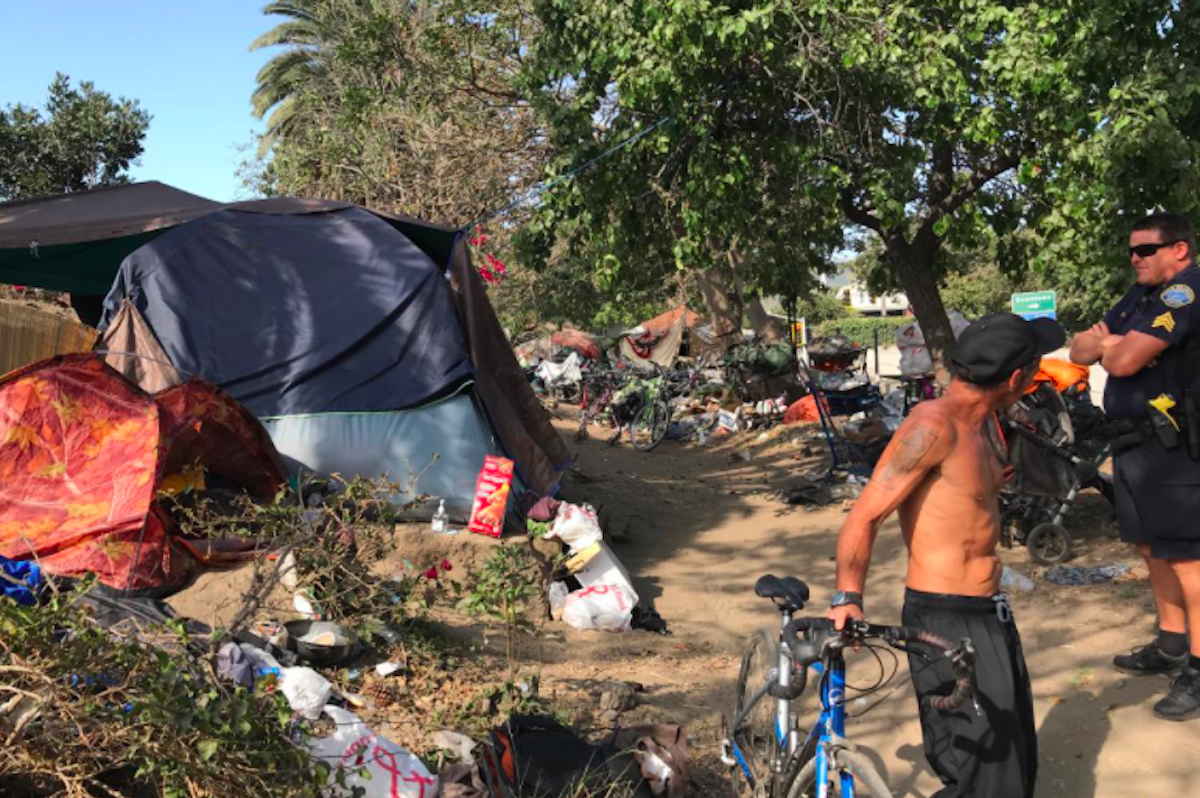Much Love for Santa Barbara’s ‘Bridge Housing’ Model
But Permanent Solutions for City's Homeless Remain Elusive

Thus far, the pilot program to relocate dozens of Santa Barbara’s homeless residents from fire-prone encampments to an upper State Street motel has been “remarkably successful,” said Councilmember Kristen Sneddon in a sentiment echoed by her colleagues Tuesday. But there was also consensus among the council that there is still much more work to be done to help the unhoused find stable living space off the street.
Since June, when the city enacted the 120-day, $1.6 million program for temporary “bridge housing” at the Rose Garden Inn, crews have removed a mountainous 30 tons of material from six abated camps ― where 18 fires were reported in the month of May alone ― and enticed 54 people to the motel. No fires have occurred since.
At the Inn, clients are receiving a host of wrap-around services, including mental-health care provided by Cottage Hospital staff, substance-abuse treatment, and employment counseling. The program has proven so popular among the homeless community that a handful of individuals surreptitiously moved into the cleared-out camps in hopes of then being relocated to the motel.
The whole point of the endeavor is to transition people to permanent housing, explained René Eyerly, who was recently appointed interim assistant city administrator. Six have secured housing vouchers. Another six have found jobs. But the number of local property owners and managers willing to accept the vouchers is “extremely limited,” said Eyerly. More options are “desperately needed” if the program is to succeed in the long term, she said.
Most of the 215 available vouchers must be redeemed within city limits as a condition of their funding, Eyerly explained. Case managers, however, get creative where and when they can, said Brad Fieldhouse with City Net, the nonprofit driving the overall effort. One particular client was recently reunited with his family in Alaska.
Public safety in the neighborhoods surrounding the Rose Garden Inn was a concern among residents when the program was first announced. But those worries haven’t been borne out, said Police Chief Barney Melekian. The partnership between his department and City Net ― which provides 24-hour security at the site, including daily patrols up and down the street ― has been “truly outstanding,” he said.
Sign up for Indy Today to receive fresh news from Independent.com, in your inbox, every morning.
The slight increase in petty thefts and nuisance behavior nearby is a trend taking place across the city, Melekian explained, and the spike in serious crime at the location predicted by some hasn’t taken place. Noticeably, no residents spoke out during the public comment portion of the meeting. “That’s a good sign,” said Sneddon.
Councilmember Eric Friedman, who represents the district, also commended City Net. But he did note new congregations of homeless people in the parking lot behind the AAA office up the block, as well as the large lot that connects Wells Fargo and Bank of America. Fieldhouse and Melekian promised to look into it.
Eyerly acknowledged that while the six fire-prone camps beside Highway 101 and the railroad tracks are now gone, staff have observed new encampments cropping up in other parts of the city, including along creeks. “This is frustrating to the community as each neighborhood feels the impact directly, so addressing sites in one area is not satisfying to another,” she said.
Looking ahead, the council will consider next month whether to extend the pilot program, which is set to expire in November. Representatives of Santa Barbara’s existing homeless facilities ― PATH, Rescue Mission, and the Salvation Army ― will be on hand at that meeting to discuss their respective roles in chipping away at the issue. Councilmember Michael Jordan said he was eager to ask PATH why 100 of their 200 beds remain unused.
City staff will also be applying for more of the $2.75 billion in state housing funding that financed the initiative when grant applications are due in January. An existing City Hall staff position will be retooled to focus exclusively on homeless-reduction efforts, as well. Meanwhile, the county is looking at constructing 32 micro-units on downtown property it owns.
The bridge model clearly works, Friedman said. “We’re really getting somewhere.” But it’s only the first step in finding permanent homes for the people who need them, he emphasized. “We have a lot more work to do.” Mayor Cathy Murillo agreed. “When it comes down to it, we just need more housing for these folks.
Support the Santa Barbara Independent through a long-term or a single contribution.



